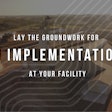
There are many upsides to dedicating time, money, and energy to a leadership development training program. A smart investment can strengthen your team and move your company forward. Nearly 60% of surveyed leaders believe training directly improves their performance. Nearly half of employees say they’d stick around longer if they received leadership development training.
Question is, are all leadership development programs created equal? No. But if you’re clear about the results you want from the training, you’re more likely to find a program that’s right for you.
Here are six things to keep in mind as you identify and assess leadership development programs.
#1: Know your business goals
Developing your leaders is a sound business strategy, not a human resources initiative. Determine how well a program aligns with your business goals by asking yourself:
- What are my business goals?
- How does the training support the goals?
- What’s the impact on my business if I DON’T provide this training?
#2: Define success
If “Complete the training program” is your definition of success, think again. True success means your leaders are using their newly acquired skills and tools. Before committing to a leadership development training, ask yourself:
- How do the skills and tools from the training align with my team’s roles and responsibilities?
- What leadership changes do I want to see as a result of the training?
- How will I gauge if the training was successful? What needs to happen AFTER the training to know it was a worthwhile investment?
#3: Assess the relevance
Leaders are more engaged when the skills and tools they’re learning directly align with situations they face in their roles. Ensure relevancy for your team by asking:
- How will program facilitators understand the goals, needs, and nature of my business?
- How will program facilitators understand what participants need?
- How will program facilitators apply and tailor the content so it’s relevant?
#4: Give it your all
Leaders will get out of the program whatever they put in. Be sure your team is committed to and accountable for using and implementing their new skills and tools. Ask:
- How will leaders be held accountable for implementing the new skills and tools?
- How will we incorporate the new skills and tools into current processes and practices?
- What buy-in do you need from senior leaders to ensure they’ll support their program participants?
- How will you support those senior leaders?
#5: Stay focused
Many leaders leave training programs feeling overwhelmed and unsure about how to apply what they’ve learned. In fact, the more concepts and tools in training, the less likely participants are to practice and implement the skills and tools. It’s important to know how the program approaches the content. Ask:
- What key skills and tools are taught in the program?
- What new behaviors should participants be implementing?
- How is the program structured to reduce overwhelm?
#6: Sustain and reinforce
Leaders’ success with turning new skills into habits depends on their post-training support. To learn how a program sustains and reinforces learning once the program ends, ask:
- How is the program customized to incorporate current business processes and practices?
- How does the program support and reinforce the learning post-training?
- How does the program support leaders as they encourage their program participants to use the new skills and tools?
We’re huge believers in the power of leadership development to get the most out of companies and teams (that’s why we developed our own Leadership Transformation Program!). We hope the information we’ve shared here will guide you as you weigh the merits of any leadership development program—so you can make an investment that truly counts.


















